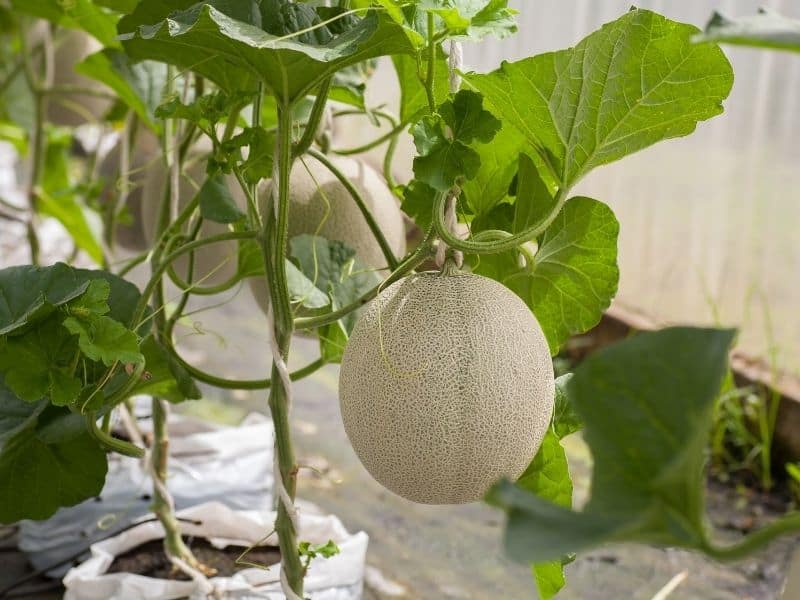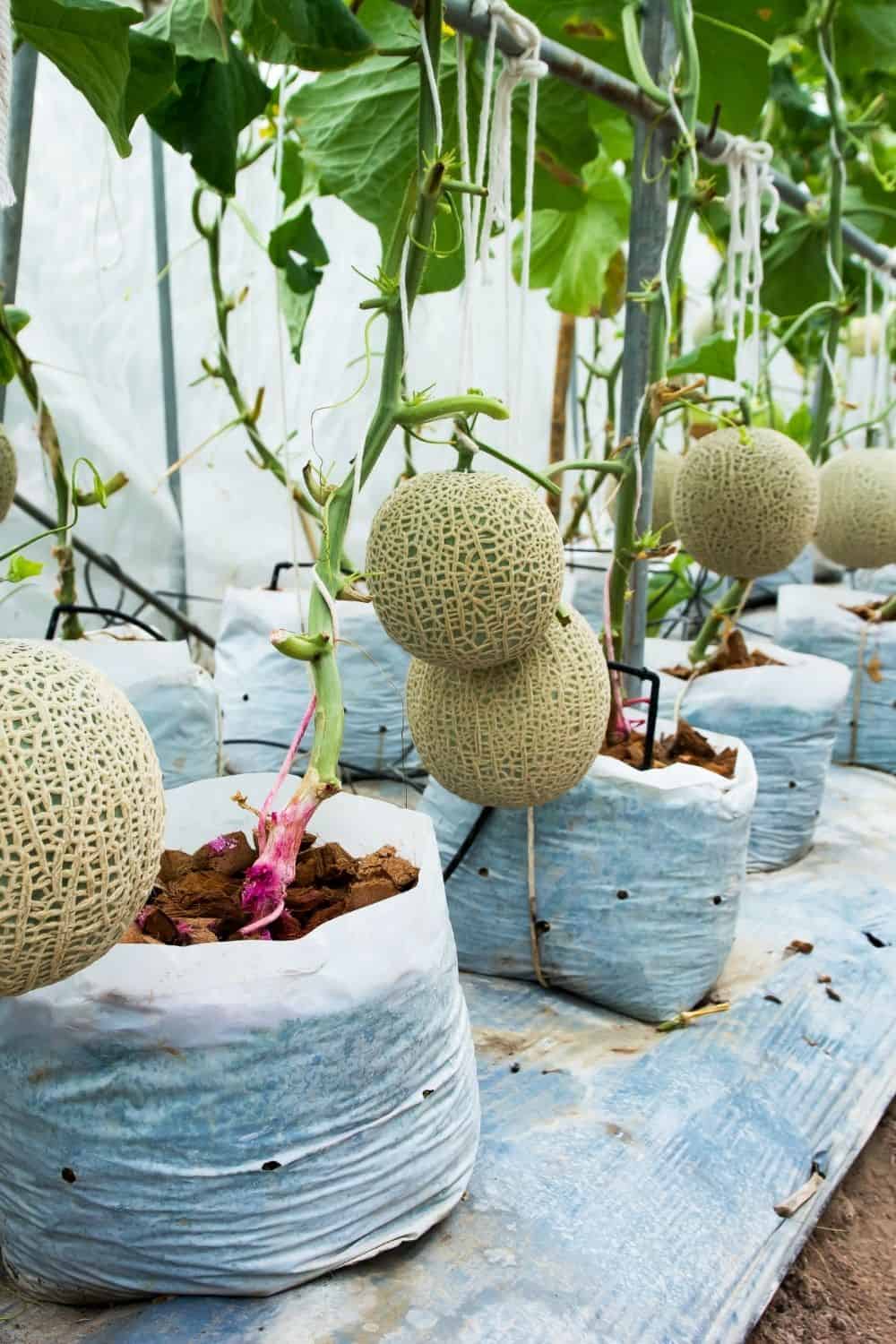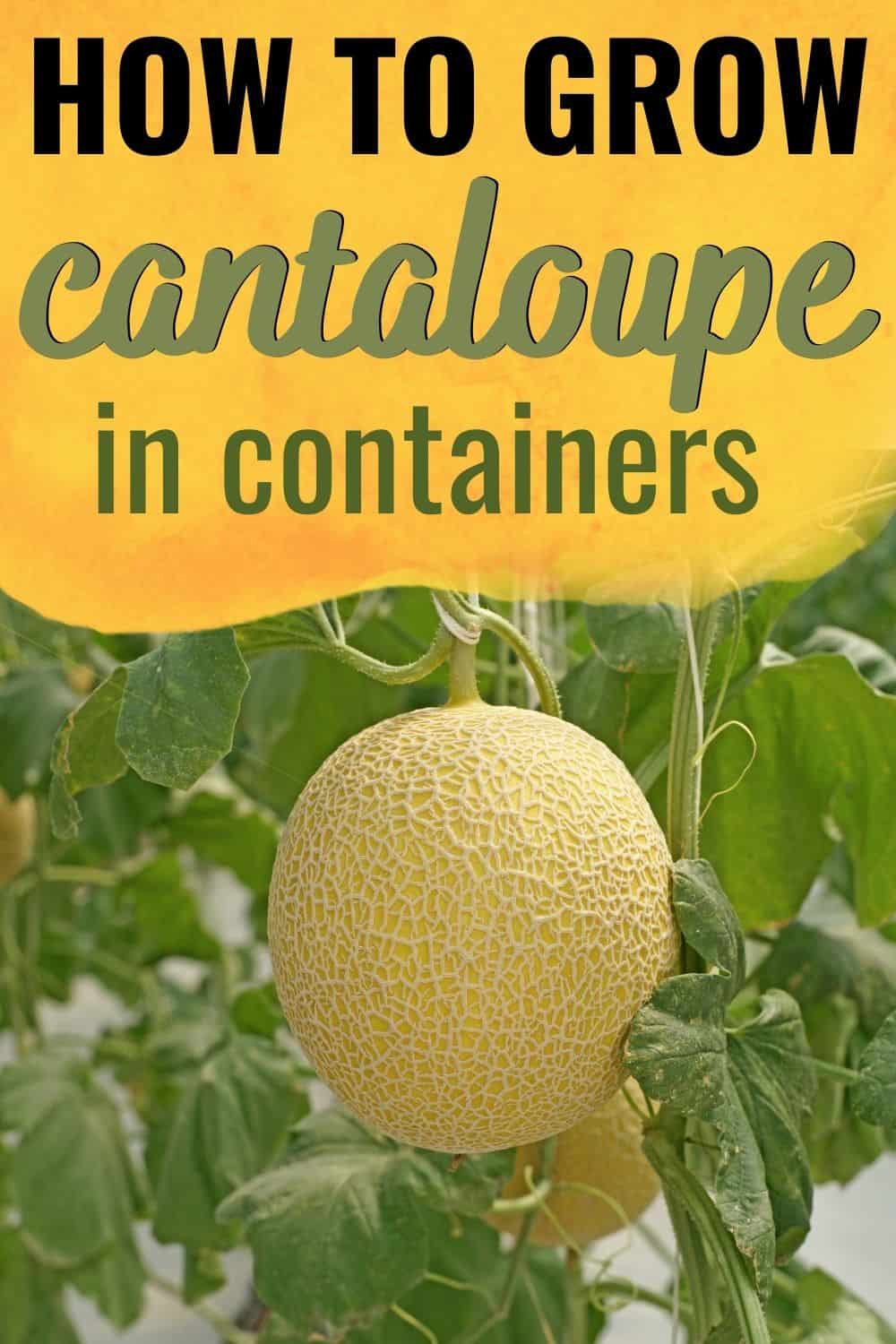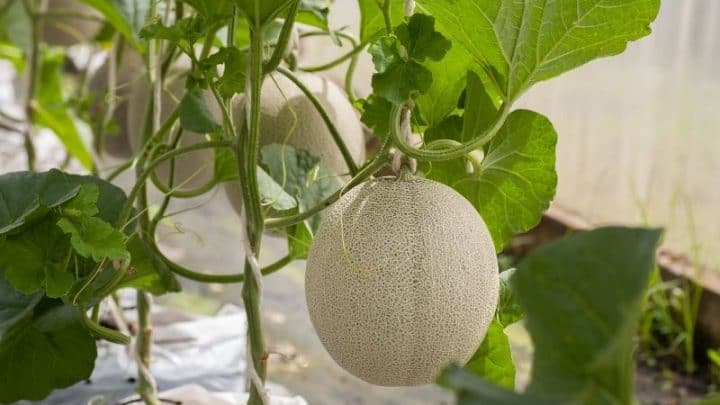No space for a sprawling melon plant? Good news! If you have a five-gallon pot and a sunny place to put it, you can still grow cantaloupe. This may seem like an odd plant for a container garden, but we’ll help you get started with tips on how to grow cantaloupe in containers, from choosing the right variety to harvesting the fruit.

How to Grow Cantaloupe in Containers
Like its cousin the cucumber, cantaloupe can be trained to grow vertically, reducing its usual sprawl and making it a suitable container plant. And growing cantaloupe in containers allows you to extend the growing season by planting earlier in the spring and bringing the young plants inside on exceptionally cold nights.
If moving pots around every day doesn’t sound like fun, you can also grow the cantaloupe in a bright window or sunroom until the weather is warm enough to move it outside full time.
Planting cantaloupe in containers
Growing cantaloupe in containers requires choosing the right type of cantaloupe — a dwarf variety usually works best — selecting a container of appropriate size, preparing a quality planting mix, and training the vines up a support structure of some kind. You can purchase seedlings from a local nursery or start your cantaloupe from seed either directly in the container or in trays.
Choose the right type of cantaloupe
Although full-size cantaloupes can be grown in containers, dwarf varieties have shorter vines and smaller melons better suited to small spaces and vertical growing. Here are a few recommended varieties:
- Sugar cube – This sweet, flavorful hybrid produces melons weighing about two pounds and has excellent disease resistance.
- Minnesota midget – An extra-early heirloom, this variety grows vines less than three feet long with an abundance of tiny, meaty melons.
- Tuscanito – This Italian hybrid produces two-pound melons with firm, sweet flesh that store well, lasting up to two weeks uncut in the refrigerator.
- Charentais – Often considered the most flavorful melon, this French heirloom produces smooth, round, grayish melons that reach about two pounds.
- Tasty bites – Growing up to two and a half pounds, these round or oval hybrid melons have a rich, sweet flavor and long shelf life.
Best containers for growing cantaloupe
For dwarf cantaloupe varieties, choose a container at least 16 inches deep and 14 inches wide, or five gallons in volume. A clean utility bucket with holes drilled in the bottom for drainage works well in a pinch, or purchase a half-barrel planter for multiple plants or a full-size variety.
Sturdy plastic, wood, terra-cotta, and even breathable fabric (grow bags or feed bags) are all great options for cantaloupe containers.
Make sure whatever container you choose has adequate drainage, and if you plan on moving the plant inside at all, it should also be easy to move and have a saucer to keep your floor dry. A lightweight pot in the smallest size necessary will facilitate this, or place the container on a dolly.
Planting mix for cantaloupe in containers
Cantaloupe will grow best in quality potting soil that drains well and contains plenty of organic matter and either perlite or vermiculite. To make your own planting mix, combine clean topsoil and compost or well-rotted manure. Adding perlite or vermiculite will help the soil retain moisture, as will a thin layer of mulch on top.
If desired, you can add an all-purpose, slow-release fertilizer to the container at the time of planting to give the seeds or transplants an extra boost, or you can wait until the seedlings are six inches tall and apply a 5-5-5 liquid fertilizer.
I always recommend organic fertilizer, especially when dealing with fruits and veggies.
How to grow cantaloupe vertically

Growing cantaloupe in a small space, whether in a garden or a container, requires a vertical support structure of some kind. The specific type doesn’t matter much, as long as it’s sturdy enough to hold the weight of several melons and matches or exceeds the mature length of the vines. Some options include:
- a tomato cage
- bamboo U-hoop
- container trellis
- even a few stakes strung with twine
To avoid damaging the roots, place the support structure in the container when you plant the cantaloupe. When the vines grow long enough to begin training up the trellis, gently wind them around the structure and tie them loosely in place with plant ties or twine. The vines should then figure out how to climb the structure on their own, but if you notice a vine heading off in the wrong direction, gently redirect and secure it to the support.
The fruit of dwarf varieties likely won’t need any additional support, but full-sized cantaloupes will put too much strain on the vines or even fall off prematurely when grown vertically. Use melon nets, old nylon stockings, or mesh produce bags to create slings for the fruits.
When the melons get about fist size, place a mesh bag or stocking around each one and secure it to the support structure, making sure the sling of choice will both support the developing fruit and expand sufficiently as it grows.
Caring for container cantaloupes
Place your container cantaloupes in a location that receives at least six to eight hours of sunlight each day, if possible. Cantaloupe plants will tolerate part shade, though they may not produce quite as well.
If starting from seed, keep the soil consistently moist until sprouts emerge, then water deeply whenever the soil feels dry. About a week before harvest, cut back on watering to allow the sugars to concentrate and to prevent cracking. Water only when the top two inches of soil feel dry and the leaves just begin to wilt. As with most garden plants, always make sure to direct water at the base of the plant to avoid wetting the leaves and thus inviting disease.
If you apply liquid fertilizer to the seedlings when they reach six inches tall (see “Planting mix” above), also add a lower nitrogen fertilizer, such as 5-10-10, when the flowers start to develop. Too much nitrogen will encourage extra leaf growth rather than fruit development.
Harvesting your container cantaloupes
Your melons will show several signs to indicate when it’s time to harvest them. The rind will turn from green to yellow and the white “netting” become a creamy golden color. Additionally, the stem will begin to separate from the cantaloupe so that a gentle tug will release it. If you’re still not sure, get a little closer and take a sniff: the melon should smell sweet, especially at the base of the stem.
Personally, I think cantaloupes taste best fresh off the vine and scooped right out of the half-shell with a spoon. But if you have several melons ripen at once or want to make them last a bit longer, store them unwashed and uncut in the fridge for up to three to five days. Some varieties, such as Tuscanito and tasty bites, will store for up to two weeks.
Disadvantages of growing cantaloupe in containers
Are there actually any downsides to having sweet, juicy melons right outside your door? Not really. You do have to put forth a little extra effort to provide support for the vines and maybe the melons, which also means a bit more expense if you don’t already have something suitable on hand. But growing cantaloupe vertically is an advantage in itself, as keeping the vines off the ground means they receive better airflow and thus are less prone to disease.
If you enjoy the juicy sweetness of a properly ripened cantaloupe, this might be the perfect addition to your container garden. As with a garden-fresh tomato, there’s really no comparison between a store-bought cantaloupe and one fresh off the vine. With a large container, good soil, and a small trellis, you can enjoy sweet cantaloupe grown right on your patio or deck.




How To Grow Beans In Containers - Tips For Delicious Bush And Pole Beans
Friday 11th of December 2020
[…] how to grow cantaloupe in containers […]